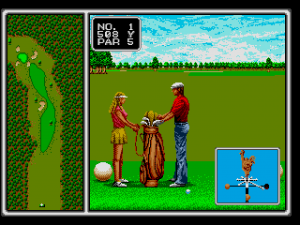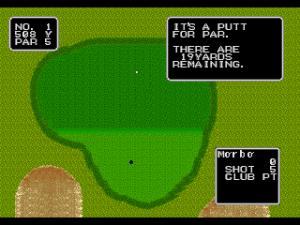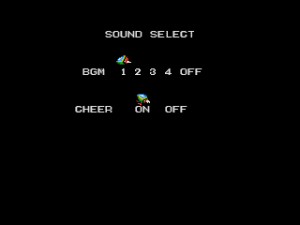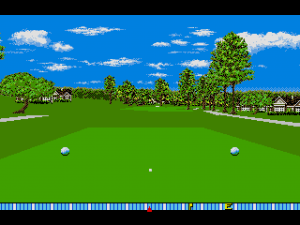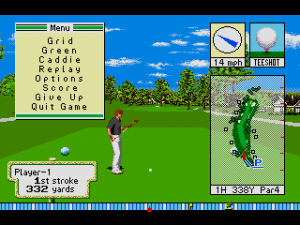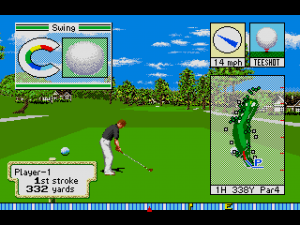The Genesis was Sega’s finest moment. Sadly, after this they took a chapter or two out of the Commodore and Atari playbook for surefire failure which is why you don’t see them making consoles any more… but that’s a story for another post.
But in the early 90s, Nintendo had to work damn hard and pull out all the stops to make the Super Nintendo competitive with the Genesis. The 16-bit console era is remembered more in North America for its fierce competition between these two excellent systems than for dominance of one over the other.
And great games were everywhere. By this time, the industry had learned that you can’t just release crap, call it a video game and expect people to buy it and want more. This isn’t to say that bad games didn’t sneak through. It’s just that legendarily bad games no longer could. One could argue that this lesson had been forgotten and even cheerily abandoned in this modern era, but again, that’s a topic for another post.
This era was also the end of those times where one or two people could design and code a video game from start to finish all by themselves. Back in the early days of the Atari 2600, the Intellivision and the like, it was common for one person to create, program and debug an entire game. By the 90s, this kind of effort took entire teams.
The golf games for the Genesis weren’t especially plentiful, but the system did have a large share of licensed sports titles. For better or for worse, licensed sports games were the standard from this point on, and it seems that most gamers were unwilling to pay for a sports title if it didn’t have someone’s name or names attached to it.
The first golf game we have up for the Genesis is “Arnold Palmer Tournament Golf” from 1989.
A high-quality game, though it has a kind of 8-bit NES look at times. The 1989 vintage is to blame for that more than anything else.
I regret to report that your computer (or even a real Sega Genesis) will not start spitting out cash or golf clubs if you win this game. Come to think of it, the golf clubs thing is probably a good thing. Thems can be heavy.
And here we see Mr. Palmer looking decades younger and hanging around with a rather perky looking caddy who doesn’t look at all like his wife. I can explain! This game was actually just a generic golf game for the “Mega Drive” (the original name for the Genesis) in Japan. When the game was released in North America, they slapped Arnold Palmer’s name and face on the box.
Pressing the C button on the gamepad will get you a little menu. It’s pretty useless. The advice is displayed on the screen automatically before each swing. The green is just a top-down view of the putting green that you see when you get there, and score is just your scorecard.
The A button on the gamepad is where the action is. Since the Genesis controller had 3 buttons, game publishers had a hard time settling on which buttons to use it seems. But once you press it, you get the wind speed window:
Press it again to see your ball lie:
Press it again to see and select your club (up and down on the direction pad):
Press once more to alter your stance:
One final press of the button will bring up the power meter and an aiming triangle. Left and right on the direction pad will aim your shot. The power meter operates with three button presses – one to start, one at the top of the swing, and one to end it.
This game loses points with me because it is too easy. If you press the button too late at the top of your swing, you aren’t penalized by being given a horrendously aimed wonky shot that sends your ball way out into the rough like it should. No, the power meter is simply reset and you are given another try. This can be done indefinitely from what I could tell. So the power meter is pretty hard to fuck up, and if you make sure you aim right and set up your stance and choose the right club, you will come out on top on most holes. At least you do have to select your club before each swing. The caddy won’t do it for you automatically.
This is what you see when you make it onto the putting green:
You can see what I mean by that 8-bit NES look. As an added bonus, there are a few phrases of Engrish here and there in the interface.
And here you are about to make a putt. The power meter requires one button-press less on the green. You are shown slope arrows before you putt, but I don’t think they affect the way the ball rolls as much as they do in other golf games, and I’ve had better success with leaving my aim as it was set by the game when I started the shot.
So, not a bad game. Too easy though. This would be good for kids. The sound effects don’t really go for a realistic feel either. There is background music playing throughout, but thankfully you can turn that off. You can also select from four types of music or silence if you wish by pressing the start button during the game:
There are also some very realistic elements in this game that have been lacking in previous games. For instance, on one shot I found myself directly in front of a tree. In previous games for previous systems, this would have likely been handled by somehow “blasting through” the tree as if it were just a mathematical formula that slowed the ball and brought it off course to a randomly chosen direction.
But this is the first game that I have seen the golf ball actually bounce off the tree like it would have actually done on a real golf course. I think from here on, we’re going to see this kind of realism as the norm.
“Pebble Beach Golf Links”, 1993
Here’s a game from four years later in the console’s life. By now, game developers should have gotten a good sense of how to take advantage of a system’s hardware, so let’s see what kind of experience we have with this one.
One of the Genesis’s weaker points when compared to it’s rival the Super Nintendo was its sound, and from the opening digitized speech sample, this game manages to output some high-quality sound for the system.
Before you start, you can set up some options. This isn’t the first game that allows tournament play, skins match play, stroke play, match play or practice, but the 16-bit console era saw the first time these different styles of play really got fully fleshed out with all possible options, bells and whistles. For my review I played a round of stroke play, but “Pebble Beach Golf Links” has tournament play that pits you against other golfers too, and keeps you updated on their progress while they play.
Once you hit the course, you get a flyby of your hole. The Genesis sound chip can produce some cheesy music, and if you don’t like the poppy synth music playing over this scene, you can skip it by pressing a button on the gamepad. Also, there is similar background music playing throughout the game. You can turn that off through the options screen, either in-game or before you start.
Here you see information about your hole displayed.
From here, you can set the view of the shot. Left and right on the direction pad will do that. This will also affect your aim. Note the wind direction and speed, as they have a big impact on your shot in this game. If you press the start button from here, you will see a view of your hole without all the windows and info:
Pressing the A button will show you a view of the hole’s putting green:
Pressing B will bring up the in-game menu:
Pressing C is where the action is.
The first thing you need to do is select your club. Your caddy automatically selects a club for you, but sometimes his decisions are a little off. Since you can’t hit him or otherwise attack him, your only option is to select a different club, and for that you need to move the direction pad either up or down.
After pressing C again, you can adjust your stance to help aim your shot. Like I said before, the wind plays a big part in this game, so keep that in mind.
The next time you press C will bring up the power meter. This one is round and it operates with two button presses. It is also connected to another aiming device in the form of that golf ball beside it. To start the swing, press C. Press C again at the top of the swing.
Immediately you will see a purple dot start to snake its way down along the top of that golf ball next to the power meter. You need to time another press of the C button to when the purple dot appears where on the ball you want the club to strike. This is yet another way you need to aim the ball and adds another layer of difficulty and complexity to the game.
This screenshot makes up for my horrible performance in ”Greg Norman’s Ultimate Golf” for the Amiga.
When you get to the putting green, you will see a terrain grid display upon the green, and an elevation graph will appear:
You can use this information to judge the slope of the green and calculate the path of your ball.
Not bad.
I’m seriously impressed by “Pebble Beach Golf Links”. It’s one of the most complex golf games I’ve reviewed to date, and it’s also one of the most rewarding. With a game like this, the time its developers spent in balancing all of the factors really shows. The look of the graphics can be a little rough sometimes, but overall they’re good. The golfer character even has some emotive reactions. On my first attempt, when I finished the hole six strokes over, he looked rather upset and embarrassed as he stood there preparing for his shot. Attention to detail goes a long way when making a game like this, and the entire thing has come together to make a satisfying whole.
“Pebble Beach Golf Links” ranks somewhere in my top ten golf games of all time.







